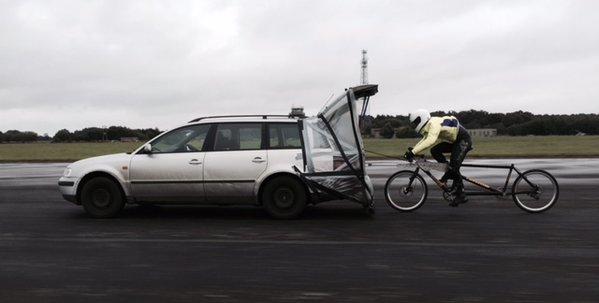- News
- Reviews
- Bikes
- Accessories
- Accessories - misc
- Computer mounts
- Bags
- Bar ends
- Bike bags & cases
- Bottle cages
- Bottles
- Cameras
- Car racks
- Child seats
- Computers
- Glasses
- GPS units
- Helmets
- Lights - front
- Lights - rear
- Lights - sets
- Locks
- Mirrors
- Mudguards
- Racks
- Pumps & CO2 inflators
- Puncture kits
- Reflectives
- Smart watches
- Stands and racks
- Trailers
- Clothing
- Components
- Bar tape & grips
- Bottom brackets
- Brake & gear cables
- Brake & STI levers
- Brake pads & spares
- Brakes
- Cassettes & freewheels
- Chains
- Chainsets & chainrings
- Derailleurs - front
- Derailleurs - rear
- Forks
- Gear levers & shifters
- Groupsets
- Handlebars & extensions
- Headsets
- Hubs
- Inner tubes
- Pedals
- Quick releases & skewers
- Saddles
- Seatposts
- Stems
- Wheels
- Tyres
- Health, fitness and nutrition
- Tools and workshop
- Miscellaneous
- Tubeless valves
- Buyers Guides
- Features
- Forum
- Recommends
- Podcast
news
 Operation Pacemaker performing speed trial in the rain at 90mph (via Twitter).jpg
Operation Pacemaker performing speed trial in the rain at 90mph (via Twitter).jpgDave Le Grys involved in budget attempt on Guy Martin's GB motor-paced speed record
Next week an attempt will be made on the British motor-paced cycle land speed record that is currently held by Guy Martin. Inspired by the Great British tradition of ‘the shed inventor,’ the Operation Pacemaker team is looking to achieve the feat for under £1,000 with funds raised going to the British Heart Foundation.
Guy Martin set the current record of 112mph on the Pendine Sands as part of his TV series Guy Martin on Speed. He did what the Operation Pacemaker team describe as a ‘proper job’ – calling on all manner of experts and making use of a top truck racing team.
In contrast, the team making this latest attempt will be using a 20-year-old converted tandem found in a garage, with functional additions such as a walking stick, scrap car parts, scrap metal, knicker elastic, exhaust mounting rubbers from a 1989 Ford Escort and an ex-RAF parachute.
Here’s the parachute launch system in action.
The parachute is needed because the team is making its attempt on the Elvington runway, which is only two miles long.
The pacing vehicle, a 1998 Diesel VW Passat which has done 244,000 miles, will be driven by Dave Le Grys, whose motor-paced British record of 110mph stood for 27 years until it was broken by Martin (but only with advice and assistance from Le Grys himself).
Le Grys underwent open heart surgery in June after learning that he had a leaky heart valve which, under stress, was pumping more blood into his lungs than his legs. He has been recovering ever since and is aiming to race at Lee Valley Velodrome on December 8.
All involved have been affected by heart disease, either by conditions requiring open-heart surgery, or by the truly devastating sudden loss of a loved one. Donations can be made on their Just Giving page.
10 Days til testing !!! We're gonna set a record for speed or the longest face plant !!! Either way its for charity folks so chip in !!
— 115mph on a bicycle! (@BHFpacemaker) November 10, 2015
Alex has written for more cricket publications than the rest of the road.cc team combined. Despite the apparent evidence of this picture, he doesn't especially like cake.
Latest Comments
- Rendel Harris 46 min 27 sec ago
I think you need to apply the adjective to both nouns, so the commentator is not referring to all boomers but only "NIMBY boomers".
- Rendel Harris 35 min 14 sec ago
What's a "legitimate cyclist" please? Someone who doesn't conform to your arbitrary norms? At the age of 56 I admit to that you have 13 years more...
- mattw 14 hours 35 min ago
This risks turning me into a hanger and flogger....
- wtjs 18 hours 41 min ago
Well, you know the BMW drivers' saying: knock that house (hospital, social housing, care home, hospital...) down, could save 30 seconds on the trip!
- Spangly Shiny 20 hours 16 min ago
I had the pleasure of owning two of the featured builders here, in my history. When I joined the Army in 1971, I took with me my curly Hetchins:...
- Username 21 hours 21 min ago
Could Siobhán paint it red and noone would notice it?
- Spangly Shiny 1 day 12 hours ago
To paraphrase Field of Dreams, "Build it right and they will come: and use it!"
- Rendel Harris 1 day 14 hours ago
And a Happy Christmas to you, road.cc staff!
- Rendel Harris 1 day 15 hours ago
The odds of not being able to find a single pedestrian - just one, note, "any pedestrian" - in an area containing more than about ten of them who...
Add new comment
8 comments
Long wheelbase will stop him pulling wheelies
115mph in two miles....That banger isn't going to reach that speed in that time frame
I'm sure the bike can get up to speed. It's the car I'd be worried about!
Best of luck anyway
Whilst waiting for someone with an understanding of engineering to comment:
My guess would be:
1. Stability at speed
2. The need to accomodate a big cog to little cog, then another big cog to little cog gearing multiplier setup
Standard dance move.
Can someone explain why the bikes that are used for these types of attempts have strange long wheelbase geometry? I'm assuming it's to do with stability at speed?
Wow. Didn't know Legro had been under the knife. Hope your recovery is going to plan, Dave.
Boardman v Obree all over again. Bring it on